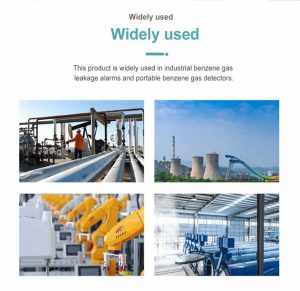-
Protecting Public Health: The Power of Gas Sensors in Air Pollution Detection
- Air pollution is a major environmental issue that affects the health and well-being of people worldwide. It is caused by various sources, such as industrial emissions, transportation, and household activities. The World Health Organizatio……
- Chat Online
-
Description
Air pollution is a major environmental issue that affects the health and well-being of people worldwide. It is caused by various sources, such as industrial emissions, transportation, and household activities. The World Health Organization (WHO) estimates that outdoor air pollution causes 4.2 million premature deaths each year. In addition, indoor air pollution causes 3.8 million deaths annually, mainly in low- and middle-income countries. Therefore, it is crucial to monitor and control air pollution to protect public health.

Gas sensors are an essential tool in air pollution detection. They can detect different types of pollutants, such as carbon monoxide (CO), nitrogen oxides (NOx), ozone (O3), sulfur dioxide (SO2), volatile organic compounds (VOCs), and particulate matter (PM). Gas sensors are widely used in various applications, such as air quality monitoring, environmental research, industrial safety, and personal exposure assessment.
One of the main advantages of gas sensors is their high sensitivity and selectivity. Gas sensors can detect even trace amounts of pollutants in the air, which is important for identifying potential health risks. For example, exposure to high levels of CO can cause headaches, dizziness, nausea, and even death. NOx emissions can lead to respiratory problems, cardiovascular diseases, and cancer. O3 can irritate the eyes and respiratory system, and exacerbate asthma and other lung conditions. SO2 can cause respiratory and cardiovascular illnesses, and harm the environment by causing acid rain. VOCs can have a range of health effects, including irritation, neurological damage, and cancer. PM can penetrate deep into the lungs and bloodstream, and cause respiratory and cardiovascular diseases, as well as premature death.
Gas sensors can also provide real-time data on air quality, which is essential for addressing air pollution. Real-time monitoring allows for the identification of pollution sources, the assessment of exposure levels, and the implementation of control measures. For example, gas sensors can be used to monitor traffic emissions near busy roads, to identify hotspots of pollution in industrial areas, or to assess indoor air quality in homes and offices. Real-time monitoring data can also be used to inform the public about air quality conditions, to raise awareness about health risks, and to promote behavioral changes, such as reducing car use, using cleaner fuels, or improving ventilation.
Gas sensors are becoming increasingly affordable and accessible, due to advances in technology and manufacturing. This means that more people and organizations can use gas sensors for air pollution detection, including individuals, communities, schools, and businesses. For example, wearable gas sensors can be used to monitor personal exposure to pollutants, and to inform individuals about their own health risks. Low-cost gas sensors can be deployed in community air quality monitoring networks, to provide localized data and to engage citizens in environmental issues. Gas sensors can also be integrated into smart buildings and cities, to optimize energy use, improve air quality, and enhance public health.
However, there are also challenges and limitations in gas sensor technology and application. Gas sensors can be affected by various factors, such as temperature, humidity, interference, and calibration drift. Therefore, it is important to ensure the accuracy and reliability of gas sensor data, and to calibrate and maintain gas sensors regularly. In addition, gas sensors may not be able to detect all types of pollutants, or to distinguish between different sources of pollution. Therefore, it is important to complement gas sensor data with other types of data, such as meteorological data, traffic data, or satellite data. Finally, gas sensors should be used in conjunction with effective policies and regulations, to reduce and prevent air pollution at its source, and to protect public health.

In conclusion, gas sensors are a powerful tool in air pollution detection, and play a crucial role in protecting public health. Gas sensors can detect different types of pollutants, provide real-time data, and are becoming more affordable and accessible. However, gas sensor technology and application also face challenges and limitations, such as accuracy, reliability, and complementarity with other data sources. Therefore, it is important to use gas sensors in a comprehensive and context-specific way, and to integrate gas sensors into broader efforts to address air pollution. By doing so, we can create a healthier and more sustainable world for everyone.
-
Recommend:
-
-
The Role of Gas Detectors in Safeguarding Public Health
Gas detectors play a crucial role in ensuring public safety…
-
Enhancing Safety Measures: Gas Detection Devices for Improved Workplace Security
Introduction: Ensuring workplace safety is of paramount imp…
-
Gas detectors are essential devices used to detect and moni…
-
Gas sensors are electronic devices that detect, measure, an…
-
 : +86 155 8830 2704
: +86 155 8830 2704 : jxdziot@gmail.com
: jxdziot@gmail.com
